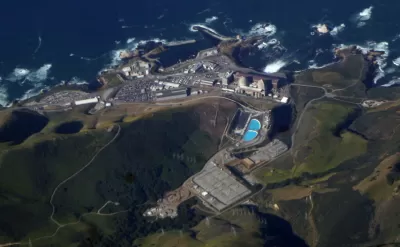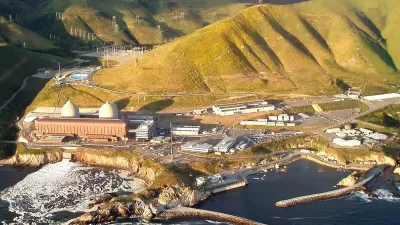In order to to ensure that the lights stay on, the California legislature approved allocating up to $75 million to extend the life of the state's sole remaining nuclear plant and four natural gas powered plants, to the chagrin of environmentalists.

"The funding is part of a contentious bill that aims to address a couple of Gov. Gavin Newsom’s most pressing concerns — maintaining the reliability of the state’s increasingly strained power grid, and avoiding the politically damaging prospect of brown-outs or blackouts," writes Nadia Lopez, an environmental reporter for CalMatters, in the source article updated on June 30.
The energy trailer bill negotiated by Gov. Gavin Newsom’s administration and approved by lawmakers late Wednesday allocates a reserve fund of up to $75 million to the state Department of Water Resources to prolong the operation of aging power plants scheduled to close.
More on extending the lives of those aging natural gas power plants was reported earlier by CalMatters environmental correspondents Rachel Becker and Julie Cart:
As part of the budget’s energy package, legislators also are negotiating provisions that would prolong use of four natural-gas power plants that are now scheduled to begin going offline next year [pdf]. The closures already were delayed by state officials by three years.
Lopez notes that if "the Newsom administration choose to extend the life of the nuclear plant, the funding would allow that — although the actual cost to keep the 37-year-old facility owned by Pacific Gas and Electric is not known."
While it’s true that the energy bill doesn’t itself authorize the extension of the plant’s life, it does provide the money should state leaders decide to do so. Such a move would require “subsequent legislation and review and approval by state, local and federal regulatory entities,” said Lindsay Buckley, a spokesperson for the California Energy Commission.
Budget signed!
The record-breaking $308 billion budge was adopted after "Gov. Gavin Newsom signed the bill, and more than two dozen others that guide how the money will be spent, on Thursday, calling it an investment in 'our core values at a pivotal moment,' wrote CalMatters' Capitol reporter, Alexei Koseff on June 30.
PG&E's decision
As noted in a related post, "Extending the Life of California's Largest Power Plant" (May 31, 2022), the decision to apply for federal funding in a new energy program in the Infrastructure Investment and Jobs Act (aka Bipartisan Infrastructure Law signed by President Biden last November) to prolong the life of the 2,256 MW power plant, the state's largest, would have to come from the owner, the Pacific Gas and Electric Company (PG&E), the nation's largest utility (by revenue).
Rob Nikolewski, the energy reporter for The San Diego Union-Tribune, wrote on July 6 that the utility plans on doing so now that the U.S. Department of Energy has made a technical revision allowing for the application.
Suzanne Hosn, spokeswoman for PG&E, said that given the revision and Newsom’s “request that we take steps to preserve Diablo as an option to promote grid reliability, we expect to submit an application for the (Department of Energy) funding.”
Opposition and support
Many in the environmental community remain steadfastly opposed to extending the life of Diablo Canyon.
“Sierra Club California is deeply concerned with Governor Newsom’s obsession with continuously funding dangerous and polluting energy resources," stated Sierra Club California director Brandon Dawson in a press release on July 7.
Instead of propping up outmoded nuclear plants, Newsom should instead be providing more resources and funding to deploy renewable energy infrastructure across California.
Nikolewski noted that a group of 37 scientists, academics and entrepreneurs sent a letter to Energy Secretary Jennifer Granholm on June 27 in support of revising the Civil Nuclear Credit Program’s eligibility to include Diablo Canyon.
“While California boasts a very high portion of electricity from renewable sources, California will have to boost its total renewable energy production by an enormous 20 percent in just two years to replace the clean energy being produced at Diablo Canyon,” the letter said.
Related: 4 posts tagged Diablo Canyon
FULL STORY: California may rescue its last nuclear power plant — and give PG&E millions to do it

Planetizen Federal Action Tracker
A weekly monitor of how Trump’s orders and actions are impacting planners and planning in America.

San Francisco's School District Spent $105M To Build Affordable Housing for Teachers — And That's Just the Beginning
SFUSD joins a growing list of school districts using their land holdings to address housing affordability challenges faced by their own employees.

The Tiny, Adorable $7,000 Car Turning Japan Onto EVs
The single seat Mibot charges from a regular plug as quickly as an iPad, and is about half the price of an average EV.

Seattle's Plan for Adopting Driverless Cars
Equity, safety, accessibility and affordability are front of mind as the city prepares for robotaxis and other autonomous vehicles.

As Trump Phases Out FEMA, Is It Time to Flee the Floodplains?
With less federal funding available for disaster relief efforts, the need to relocate at-risk communities is more urgent than ever.

With Protected Lanes, 460% More People Commute by Bike
For those needing more ammo, more data proving what we already knew is here.
Urban Design for Planners 1: Software Tools
This six-course series explores essential urban design concepts using open source software and equips planners with the tools they need to participate fully in the urban design process.
Planning for Universal Design
Learn the tools for implementing Universal Design in planning regulations.
Smith Gee Studio
City of Charlotte
City of Camden Redevelopment Agency
City of Astoria
Transportation Research & Education Center (TREC) at Portland State University
US High Speed Rail Association
City of Camden Redevelopment Agency
Municipality of Princeton (NJ)




























